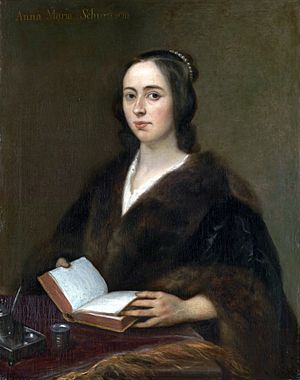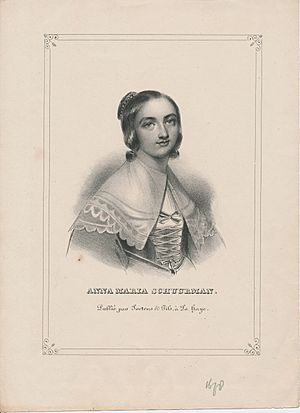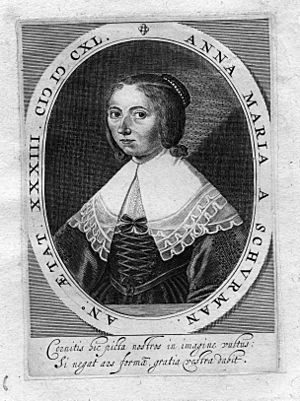Anna Maria van Schurman facts for kids
Quick facts for kids
Anna Maria van Schurman
|
|
|---|---|

Anna Maria van Schurman, by Jan Lievens, 1649
|
|
| Born | November 5, 1607 Cologne, Germany
|
| Died | May 4, 1678 (aged 70) Wieuwerd, The Netherlands
|
| Nationality | Dutch |
| Education | University of Utrecht |
| Style | Painting Engraving Poetry |
Anna Maria van Schurman (born November 5, 1607 – died May 4, 1678) was an amazing Dutch artist, writer, and scholar. She was known for being incredibly smart and for speaking up for girls' education.
Anna Maria was very well-educated. She was great at art, music, and writing. She could speak and write in fourteen different languages! These included Latin, Greek, Hebrew, and Arabic, plus many European languages of her time. She was also the first woman to study (unofficially) at a Dutch university.
Contents
Her Life and Learning
Anna Maria was born in Cologne, Germany. Her parents were wealthy. She could read by the age of four. When she was six, she was already making very detailed paper cut-outs. At ten, she learned embroidery in just three hours.
She also invented her own way of sculpting in wax. She said she had to figure out many things on her own. Her wax self-portrait was so real that a friend, the Princess of Nassau, had to poke it to make sure it wasn't alive!
Around 1613, her family moved to Utrecht in the Netherlands. About ten years later, they moved to Franeker. From age 11, her father taught her Latin and other subjects alongside her brothers. This was unusual because girls from noble families usually didn't learn classic subjects.
She learned Latin by reading books by Seneca. She also learned a lot by writing letters and talking with famous professors like André Rivet and Gisbertus Voetius.
Anna Maria was skilled in many arts. She was good at painting, paper-cutting, embroidery, and wood carving. She also taught herself calligraphy (fancy handwriting) just by looking at a book. Once she mastered it, she created her own styles to write in all the languages she knew.
After her father passed away, her family moved back to Utrecht in 1626. In her 20s, her home became a popular meeting place for smart people. She became friends with important figures like Constantijn Huygens. In the 1630s, she studied engraving with Magdalena van de Passe. She combined engraving with her calligraphy skills. Her engraved calligraphy became very famous. Anna Maria was serious about her art. She believed God had given her great artistic gifts.
Studying at University
In 1634, Anna Maria was asked to write a poem for the opening of the University of Utrecht. In her poem, she praised the city and the new university. She also pointed out that women were not allowed to study there.
Because of her poem, the university let her attend lectures by Professor Voetius. In 1636, she became the first female student at any Dutch university. Since women were not usually allowed, she had to sit behind a screen or curtain so the male students couldn't see her.
At the university, she studied Hebrew, Arabic, and other ancient languages. Her interest in ideas, religion, and art made her famous. People called her the "Star of Utrecht." By the 1640s, she could speak 14 languages. She wrote in Latin, Greek, Hebrew, Italian, French, Arabic, and Dutch.
Anna Maria was also good at math, geography, and astronomy. Many men wanted to marry her, including Constantijn Huygens. But she chose not to marry. She wanted to focus on her studies and her religious beliefs. Her motto was Amor Meus Crucifixus Est, meaning "My Love Has Been Crucified." This showed her deep devotion to her faith.
Her Art and Connections
Schurman made beautiful engravings by using a diamond on glass. She also sculpted, modeled in wax, and carved ivory and wood. She painted many portraits. She was the first Dutch painter known to use pastels in a portrait. In 1643, she was accepted into the St. Luke Guild of painters. This showed that her art was officially recognized.
Anna Maria wrote letters to many smart women across Europe. She corresponded with Birgitte Thott from Denmark, who translated old books. Thott believed women should have the right to study. Schurman praised Thott and called her the "tenth Muse of the North."
Through her letters, Anna Maria built a network of learned women. They often discussed the importance of women's education. She admired educated women like Lady Jane Gray and Queen Elizabeth I.
In 1638, some of her writings about women's education were published without her permission. So, in 1641, she decided to publish her own official book in Latin. In 1657, it was published in English as The Learned Maid or, Whether a Maid may be a Scholar.
Joining the Labadists
When Anna Maria was in her 60s, she became a leader in a religious group called the Labadists. In the 1660s, she felt that the main church was not spiritual enough. She wanted to reform the church. She traveled and met with ministers, wishing for more devotion.
In 1661, her brother met a French priest named Jean de Labadie. Labadie believed that true followers of God should live separately from others. In 1662, Labadie stayed at Anna Maria's house in Utrecht. She supported him even when he was removed from his church role.
In 1669, Labadie started a new church in Amsterdam. Anna Maria sold her house and some of her books to join his community. She published a pamphlet saying the church needed to change. She believed God's people should be separate from the "worldly" people.
This caused a public outcry. Her intellectual friends, like Huygens, criticized her. But Anna Maria became even more confident in her writing. When the Labadists had to leave Amsterdam, Anna Maria helped them. Her friend, Princess Elisabeth of Bohemia, invited them to live at an abbey in Germany.
The Labadists lived there from 1670 to 1672. Anna Maria continued her art and helped with their printing press. The Labadists called her Mama and Labadie Papa. In 1672, they moved to Altona in Denmark.
In 1673, Anna Maria published Eukleria, or Choosing the Better Part. In this book, she defended her choice to follow Labadie. She also argued against those who thought women should have a limited public role. This book was well-received by many important thinkers.
When Labadie died in 1674, Anna Maria thought about moving to England. But the Labadists moved to a village in the Netherlands called Wieuwerd. Many new members joined, including the famous artist Maria Sibylla Merian. About 400 Labadists lived there, sharing everything and trying to live like the early Christians.
In her last years, Anna Maria was often sick with rheumatism and stayed at home. She kept writing letters and working on the second part of her book Eukleria. She passed away in 1678 at the age of 70.
Her Published Works
Anna Maria van Schurman's writings were published many times during her life. Some of her most famous works include:
- "De Vitæ Termino" (On the End of Life). This was published in 1639.
- "The Learned Maid or, Whether a Maid may be a Scholar" (1659). This book came from her letters about women's education.
* In it, she used Jane Grey as an example of why girls should be educated. * She argued that teaching women languages and the Bible would help them love God more. * Even though more wealthy families were educating their daughters, girls and women still didn't have formal access to schools. * Anna Maria argued that women have a "rational soul" (a thinking mind) just like men. This meant they had a right to be educated. * She believed that women could learn any art or science. * She didn't think all women should go to school, but that upper-class women should have access to higher education. * She said women could contribute a lot to society. She also felt it was important for their happiness to study theology (religion), philosophy (ideas), and sciences.
- "Nobiliss. Virginis Annae Mariae a Schurman Opuscula Hebraea Graeca Latina et Gallica, Prosaica et Metrica" (Minor works in Hebrew, Greek, Latin and French in prose and poetry by the most noble Anne Maria van Schurman). This was a collection of her writings, including letters. It was published in 1648.
- "Eukleria, or Choosing the Better Part" (1673). This book defended her choice to follow the Labadists and shared her religious ideas.
Her Engravings
When Anna Maria van Schurman showed her artistic talent early on, her father sent her to study with the famous engraver, Magdalena van de Passe, in the 1630s. Her first known engraving was a self-portrait from 1633. She found it hard to draw hands, so she often hid them in her self-portraits.
In another self-portrait engraving from 1640, she wrote a Latin message. It said: "See my likeness depicted in this portrait: May your favor perfect the work where art has failed."
Tributes
- Judy Chicago's feminist artwork The Dinner Party (1979) includes a special place setting for van Schurman.
- From 2000 to 2018, a marble statue of van Schurman was in the Dutch Parliament building in The Hague.
- Her name appeared on a blackboard in an episode of the TV show The Good Place (2022), listed as one of the most worthy people.
See also
 In Spanish: Anna Maria van Schurman para niños
In Spanish: Anna Maria van Schurman para niños
- List of Orientalist artists
- Orientalism





